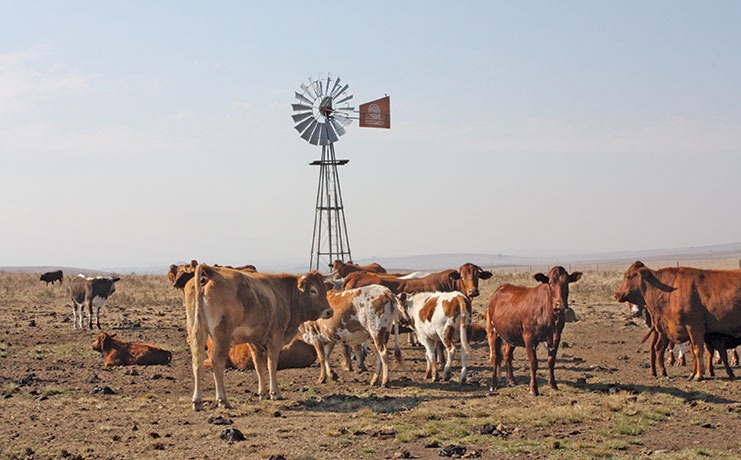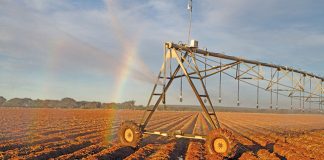
Photo: Lindi Botha
The general perception that livestock is a major contributor to global warming started in 2006, when the UN’s Food and Agriculture Organization published the study, ‘Livestock’s Long Shadow’, which indicated that livestock is responsible for 18% of greenhouse gas (GHG) emissions.
This figure has since proved to be a gross overestimation, with real figures coming in at 5% to 10%.
In South Africa, the agriculture sector’s contribution to GHG is 8% to 9%, with livestock contributing between 5,5% and 6%.
In addition, a recent study on global nutrition called for a drastic reduction in red meat consumption, citing health and environmental risks associated with red meat production.
‘Food in the Anthropocene: the EAT-Lancet Commission on healthy diets from sustainable food systems’, a report published in The Lancet, seeks to promote an environmentally sustainable and optimally healthy diet for the world’s people by 2050.
Its core recommendation is to minimise consumption of animal foods and replace them with whole grains, legumes and nuts. The recommended daily allowance of red meat is 7g, with 300g of vegetables, 50g of legumes and 25g of nuts.
This report has made waves in health and farming communities, with vegan lobbyists using it to campaign against beef production. However, the commission’s arguments have come under fire from nutritionists, who have labelled them vague, inconsistent and unscientific.
Figuring out the figures
Prof Michiel Scholtz, a specialist researcher in applied animal breeding at the Agricultural Research Council, notes that the controversy over beef production’s contribution to GHG emissions stems from an incorrect understanding of the numbers.
“In industrialised countries, the GHG emissions for agriculture are less than 6%, simply because the contribution of energy sectors, such as mines, to GHG emissions is large. In non-industrialised countries, the relative contribution by agriculture can be 40% to 50%, but the actual contribution can be considerably less than the 6% by industrialised countries.”
He says that when considering mitigation options, it is obvious that a 10% reduction in GHG emissions by the energy and mining sectors would be far more effective than a 10% reduction in the 5% to 10% contribution of agriculture.
Scholtz adds that ruminant livestock are important to humans, as most of the world’s vegetation biomass is rich in fibre, which only ruminants can convert into high-quality protein sources, such as meat and milk, fit for human consumption.
“This will need to be balanced against the concomitant production of methane. Moreover, other sources of protein for human consumption would be required, which may have an even higher carbon footprint.”
Livestock agriculture is the world’s largest user of land resources. In South Africa, about 84% of the land surface area is available for farming. However, Scholtz points out that a large part of this is unsuitable for crop production, with only about 13% being arable.
“The greater part of South Africa [71%] is suitable only for extensive livestock farming. In Africa, subsistence farmers keep livestock for multiple purposes. Rural households depend on livestock for milk, meat, hides, horns, fertiliser and income, making it central to their livelihoods and well-being.”
Greenhouse gases
Scholtz says that despite primary beef cattle farming (the cow- calf production cycle) being largely extensive in South Africa, more than 75% of cattle slaughtered in the formal sector are finished off in feedlots on maize and maize byproducts.
“The cow-calf portion of the production cycle accounts for 72% of the nutrient requirements from conception to harvest.
“Under natural rangeland conditions, decomposition of manure is aerobic, leading to production of carbon dioxide [CO2] and water [H2O] as end-products. Part of the CO2 released from the aerobic digestion of manure is absorbed during the regrowth of the surrounding vegetation rather than released into the atmosphere. The carbon sequestration measurement of this has been neglected and therefore the quantitative effect is not known.”
As cattle in South Africa are fattened in feedlots for about 110 days, they produce GHG for only 110 days before being slaughtered.
“For cattle on rangeland or pasture, it requires more than 200 days to finish to the same carcass classification because of the lower-quality feed compared to a feedlot diet.
“Furthermore, there’s substantial evidence indicating that organic production systems consume more energy and have a bigger carbon footprint than conventional production systems,” Scholtz says.
For example, organic grass-fed cattle require about three times more energy per kilogram of weight gain and release more than double the quantity of GHGs per kilogram of weight gain than conventional feedlot cattle. Organic systems thus actually have a higher carbon footprint.
“Africa’s farming practices are, however, in sharp contrast to intensive systems in large parts of Europe and North America, where large quantities of manure are stockpiled, often for long periods, and undergo anaerobic decomposition. Anaerobic decomposition of manure, as found in intensive cow-calf systems, feedlots and intensive dairy systems, produces methane as one of the major end-products, hence the concern over environmental impact.”
Scholtz says the figures usually quoted about the effects of methane from livestock are based on questionable assumptions.
“The most important GHGs and the contribution to total emissions are CO2 (49%), methane (18%) and nitrate gases (6%).”
Sources of methane production include wetlands (22%); gas and coal mining or natural gas (19%); enteric fermentation in ruminants (16%); rice cultivation (12%); biomass burning (8%); land fills (6%); and animal waste (5%).
Scholtz calculates that ruminants contribute 21% of methane production (16% from fermentation and 5% from waste). However, methane forms only 18% of GHG; 21% minus 18% is 3%. “Thus, ruminants’ contribution to GHG is less than 4%.”
The global warming potential of methane is 23 times that of CO2 but its atmospheric lifetime is only 12 years, compared with 100 to 200 years for CO2.
“Although methane has a larger effect, the duration of the effect is much shorter. This is one of the aspects that is frequently ignored.”
It is important to ask what would happen to the vegetation were it not consumed by ruminants.
“The vegetation would either be consumed by other animals that would also emit methane; it would burn, which would produce CO2 that is released into the atmosphere; or it would rot and produce nitrate gases with a global warming potential about 300 times more than that of CO2.”
Improving efficiencies
Scholtz says there are several climate-smart approaches that can be put in place to mitigate the effects of climate change on livestock production and reduce GHG production.
These centre on improving efficiency to produce more beef with the same or fewer resources.
The first of these is to farm South Africa’s adapted landrace breeds.
“There are a large number of indigenous livestock breeds in Africa that can survive in harsh local conditions and that are therefore more efficient,” he says.
In the case of ruminants, extensive systems usually have a lower per-area carbon footprint than grain-fed systems but a higher footprint if expressed in terms of kilogram of product.
“Feedlots maximise efficiency of meat production, resulting in a lower carbon footprint. Cows on pastures produce more methane than cows on high-concentrate diets.”
Dr Heinz Meissner, programme director for research and development at Milk South Africa, says farmers who improve efficiency can produce the same output from fewer animals.
“This includes shortening the time from conception to slaughter, and carrying as few as possible non-productive animals. Feeds such as grain and protein supplements produce less methane than roughage or forage, which means that supplementation or feedlotting will assist in emissions reduction.”
Carbon sequestration
Green manure and cover crops have high potential to sequester carbon, arguably higher than anything other than agroforestry. These are any plants that farmers use to fertilise the soil or help control weeds.
This is, in effect, a fallowing system in which both the fallowing function and crop production occur simultaneously on the same land.
Carbon sequestration has two to three times the potential to limit the carbon footprint.
“This is almost exclusively in the hands of agriculture, forestry and natural systems like pristine areas and parks. For agriculture, this means good vegetative cover of the veld and pastures, so there’s no erosion, or croplands that are not tilled or minimally tilled; planting trees and shrubs; not disturbing the ecosystem and wetland areas on the farm; and practising conservation agriculture or regenerative agricultural practices with cover-crop species in crop production.”
In crop farming, conservation agriculture with no or minimum tillage will limit CO2 released into the atmosphere and assist in carbon sequestration.
“If the soil health and nitrogen status are improved by cover crops and organic fertilisers, such as manure, rather than chemical fertiliser, less nitrous oxide will be released. On-farm emissions can also be reduced by using environmentally friendly energy sources such as solar or wind.
“If livestock farmers follow at least some of these guidelines in emission reduction and especially carbon sequestration practices, their farms can be carbon-neutral or better.”
Email Prof Michiel Scholtz at [email protected] or Dr Heinz Meissner at [email protected].











